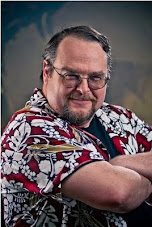I intended to do this during the holiday season - take a flat out day off from the day job and take the Lovely Bride to the SAM (Seattle Art Museum - best known for the "Hammering Man" outside its doors). I wanted to go on a weekday because the weekends tend to be a bit crowded. We haven't been there since the SAM re-opened after a major expansion. The excuse not to put it off any longer was the last days of S'Abadeb - the Gifts, a display of Pacific Coast Salish Arts and Artists. And I figured that even the Friday before close, it would not be too crowded.
Well I was sort of right. I had forgotten school groups, and a cascade of mildly hyper snowflakes was enough to put anyone off their reflective game. In general, though, the kids were well-behaved, but the voluminous hall of the display bounced what noise they made back on itself, so even now I have a mild headache.
The display itself was on the artistic end of the Salish peoples (who inhabited the Sound area before the Euro-Americans showed up), and while it covered all manner of fish clubs, cat-tail beaters, and wool spindle wheels, I don't think it made the link between these items and everyday life. Mind you, this is an art museum, not a museum of culture, societies, or anthropology, so any sort of display walks the careful line, and artifacts assembled varied from the mundane to the marvelous.
And for the Cthulhian-minded, they had a modern work, a bentwood cedar box by John Marston called The Legend of Octopus Point which just screams Lovecraft in the Pacific Northwest.
But what we particularly moving were the ghosts. There were a number of empty display podiums, lit but unoccupied, the explanation tag giving some quote involving loss. And if you hung about the displays (and the thundering snowflakes were not around), you could hear a rattle, or a chant, or a voice. It was actually very affecting about the idea of what has been lost in the acclimation of the Salish people to western ways, and made the other, physical artifacts all the more poignant.
There was also a small (10-piece) display on Edward Hopper titled Edward Hopper's Women, but which really could be called Edward Hopper - Even Creepier Than You First Thought, since it delves into more of his voyeuristic tendencies and obsessions. The presentation was tiny, and the LB noted repetitious in its commentary, but still nice.
Lunch at the Pike Place BrewPub at the market, solid food made wonderful by a very knowledgeable and friendly wait-person (who explained how and why they "air-fry' their fish and chips, brings the LB a brown mustard sauce they from another dish for her Reuben). Back to the museum for another short walkabout.
The rest of the museum is still a work in progress. For most of its history, the museum has been in a rather tight vertical operation, and now that they have spread out, it feels like when you moved into your first house and all the stuff from the apartment looks lonely and small. It's pretty much like that. The lobby is overtaken by a massive installation made up of ten white Ford Tauruses/Mercury Sables pitching end-over end in a three-dimensional stop motion animation of a car crash. It is called Inopportune: Stage One, by Cai Guo-Qiang. Supposedly a response to 9/11, it instead strikes me as the nature of an idea as catalyst - car take flight, is brilliantly lit up, flips out of control, but in the end comes to rest unharmed (though they have a museum docent at both ends of the installation to keep people from touching the parked cars). Trust me to see a happy ending in this piece of art.
Similarly, the museum now has space for Some/One, a 40'wide armored gown made of dog tags. Earlier it had to be tucked under itself. And there is room for Mann und Maus, a sculptural whimsy of a ten-foot tall rodent sitting on a sleeper's chest.
But in general it feels like the museum hasn't quite figured out how to live in its new space. African masks lead to Islamic writings lead to Egyptian/Roman, and Greek sculpture. Its not quite chronological not quite geographical, nor even thematic. It just is stuff that should be displayed, but does not come together yet in terms of making an entire presentation. How does the Italian room fit in? What about porcelain room?
Eventually, like people moving furniture about, the museum will figure it out, understand what its priorities are and how to present them. They did wonders with the economy of space they had allotted previously, and should, over time come to terms with the new opportunities presented.
And yeah, the Salish show closes on Sunday, but if you get a chance, check it out.
More later,
This Cat Likes Catnip
-
So, some cats like catnip and some don't. Some really, really like it and
some can take it or leave it. And then there's some who will abandon all
digni...
2 days ago


